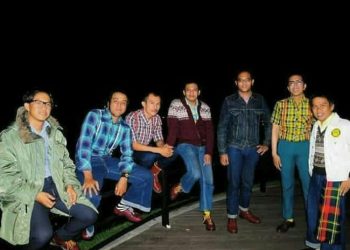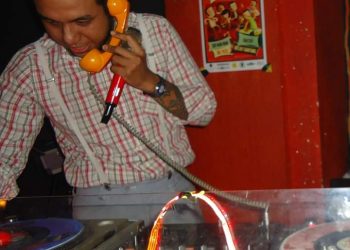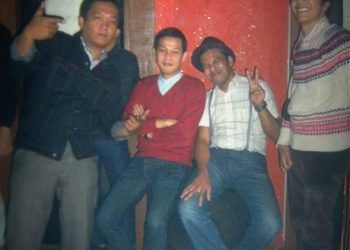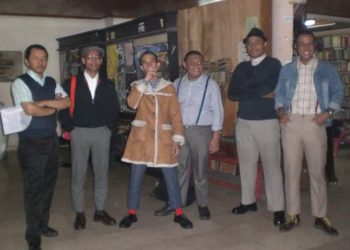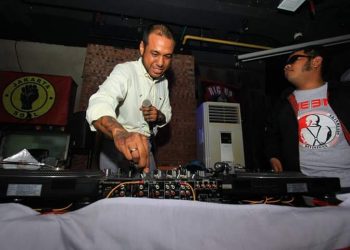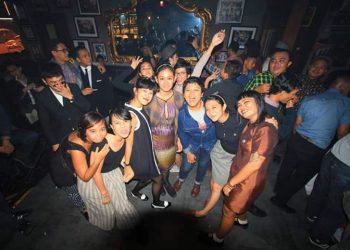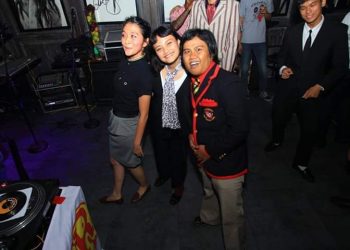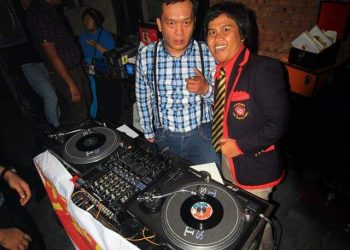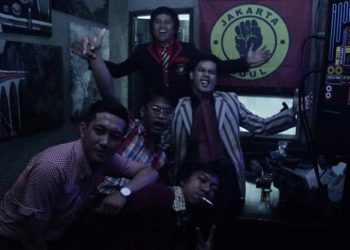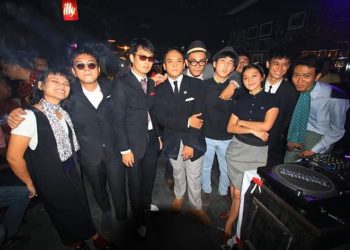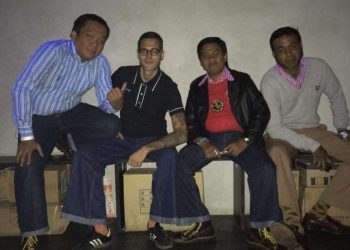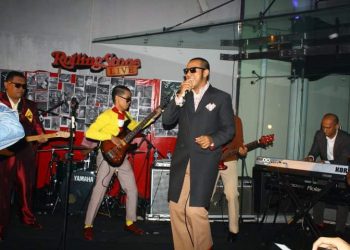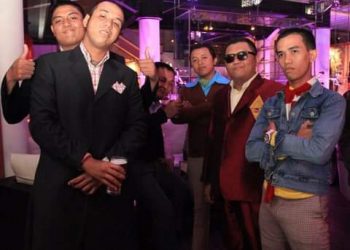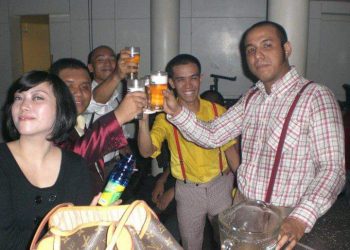Escrito por: Hendrawan K. Wijaya (Kawesome) – Traducción y correeciones por: Ronald Koeman
En Indonesia, especialmente en Yakarta, la escena skinhead está bastante extendida. En Yakarta, los skinheads se interesan por los aspectos más culturales. Refiriéndose al producto de la entrevista de Asia Taylor con skinheads en Yakarta, esta entrevistó con éxito a uno de las primeras personas en convertirse en skinhead en Yakarta. Taylor mencionó que Utay fue el primer skinhead en Indonesia. Utay formó un Oi! banda, llamada The End. Utay solía expresar los valores de igualdad y el valor de los trabajadores en sus canciones. “Ser skinhead es diferente del skinhead nazi al que también llamamos bonehead. Ser skinhead es una forma de vida. Somos héroes de clase trabajadora”, explicó Utay. Desde principios de los 90, Utay ha introducido skinheads en Yakarta.
Todo comenzó creando una etiqueta discográfica y una tienda de ropa skinhead, ambas llamadas ‘Warriors’. También hizo una canción al respecto. Utay explicaba la historia de cómo se familiarizó inicialmente con la subcultura skinhead: “Cuando llegué a Yakarta no había skinheads. Cuando estudiaba en Singapur recibí un libro sobre la subcultura skinhead. Le mostré el libro a mi amigo en Yakarta y hablamos largo y tendido sobre el tema. Con el tiempo, más y más personas comenzaron a interesarse”, decía Utay.
En el libro Skinhead, Utay encontró una imagen de cómo algunos skinheads se habían apoderado del racismo y la intolerancia. Él trajo el libro cuando regresó a Indonesia y lo presentó a la comunidad punk que había aquí. Y desde entonces, la subcultura skinhead se ha desarrollado pero con un estilo indonesio. “Es como la fusión de la cultura occidental con la cultura indonesia. Adaptamos la vestimenta, la ideología y la forma de vida del skinhead sin dejar de mantener la cultura tradicional de Indonesia. Es lo mismo que la cultura británica mezclada con Jamaica y convertirse en skinhead”, añadía Utay. Los skinheads en Indonesia se centran más en la hermandad, la música y la moda. Taylor escribió que, en un concierto en Yakarta 2017, se vio a personas con peinados con crestas y chaquetas vaqueras con botones metálicos. Una banda punk de Texas, ‘The Elected Officials’, actuaba como cabeza de cartel junto con otras bandas punk y skinhead. La vocalista de la banda, Sophie Rousmaniere, habló sobre la escena Oi!, que es un género de música derivado del punk: “Muchos grupos skinhead del Oi! aquí están más inclinados hacia la fraternidad y la amistad, y su amor por la música. Mientras que en otras partes del mundo, algunos se centran en la ideología y hay otros que eligen la violencia o el nacionalismo”.
Los skinheads aparecieron por primera vez en Inglaterra a fines de la década de 1960. Mucha gente no sabe acerca de los inmigrantes jamaicanos que jugaron un papel importante en el surgimiento de esta subcultura al principio. En ese momento, los jamaiquinos eran conocidos como ‘Rude Boys’, que se refería a la cultura jamaicana donde esta palabra era un término en argot para ‘travieso’ u ‘obsceno’. También hay una subcultura de la clase trabajadora conocida como ‘Mod’ cuyos miembros montan en scooters, calzan Dr. Martens y escuchan punk-rock. Estos grupos luego mudaron en skinheads. Pero el deterioro de las condiciones económicas en la década de 1970 redujo el empleo para los trabajadores blancos y acusaron a los inmigrantes como la causa. Entonces, la fusión cultural y racial que inspiró el movimiento skinhead al principio, luego contradice lo que siguió. A finales de los años 70, el movimiento skinhead neonazi se extendió por Europa y América del Norte. Utay, sin embargo, comentaba que los skinheads indonesios no tenían casi nada en común con estos grupos. “No es bueno ser racista. Porque los humanos somos todos semejantes según mi religión y también ante la ley”.
Los skinheads indonesios se identificaron con los skinheads tradicionales iniciales, cuando los jamaiquinos estaban profundamente involucrados. Dessy es una de las chicas skinhead indonesias. Durante más de una década, se autodenominó skinhead e incluso tenía un tatuaje de ‘orgullo skingirl’ en el pecho. “La primera vez que conocí a un chaval punk fue cuando era adolescente. Salía con punks y también con skinheads. Luego conocí a un hombre que me enseñó acerca del libro Skinhead y finalmente elegí ser una chica skinhead. Porque los skinheads trabajan, ellos no son vagos, son limpios e inteligentes”, decía Dessy. Al igual que otros skinheads de todo el mundo, los skinheads indonesios también adoran su tierra natal y cantan canciones sobre temas políticos. “Mi banda expresa en nuestras canciones el tema de estar orgulloso de ser una nación indonesia, unidad, hermandad y orgullo de clase obrera”, decía Utay. En Indonesia, la escena skinhead se enfoca en su música y comunidad. Así que no les tengas miedo porque los skinheads aquí no buscan problemas con nadie. Con los años, con la aparición de skinheads en Indonesia que escuchan más música Oi!, hay otros skinheads que también escuchan reggae y otros sonidos jamaicanos. También han aparecido bandas de skinhead reggae como The Bovvertones, Thoriq Madani, The Jenks y otros. Además de eso, muchos skinheads en Indonesia también escuchan northern soul. Esta gente exploró por sí misma las raíces de la cultura skinhead y descubrieron que la música skinhead original es música jamaicana y también soul. Es fácil encontrar fiestas de reggae y northern soul cualquier fin de semana en Yakarta. Muchos de los skinheads en Yakarta se convirtieron en deejays y selectores que pinchan reggae en formato 7 pulgadas. Podemos nombrar a Deejay Gantung, Sir Allen y otros. Deejay Gantung tiene una colección muy poderosa de reggae, con discos de la era doradas del reggae (1968-69). En 2019, fue invitado a pinchar en el Reggae Scorcher en Sabah, Malasia. Una fiesta organizada por Nakadnas Boss Sound. Allí se presentaron en skinheads no de Malasia o Indonesia, sino también skinheads procedentes de Manila. El evento se puede decir, fue la primera pinchada de boss sounds en el sudeste asiático que reunió a skinheads de Yakarta, Manila y Sabah.
English version: Skinhead Yakarta
In Indonesia, especially in Jakarta, skinheads are quite developed. In Jakarta, skinheads explore more about culture. Referring to the results of Asia Taylor’s interview with skinheads in Jakarta, he successfully interviewed one of the first to become a skinhead in Jakarta. Taylor mentioned that Utay was the first skinhead in Indonesia. Utay formed an Oi! band, named The End. Utay often voiced the values of equality and the value of the workers in his songs. “Skinhead is different from nazi skinhead which is also called bonehead. Being a skinhead is a way of life. They are working-class heroes” – Utay explained. Since the early 90s, Utay has introduced skinheads in Jakarta. It all started by creating a record label and a skinhead clothing store, both of which are called ‘Warriors’. He also made a song about it. Utay explained how he initially became acquainted with the subculture skinhead: “When I arrived in Jakarta there were no skinheads. When I was studying in Singapore I got a book about the skinhead subculture. I showed the book to my friend in Jakarta and we discussed it. Then more and more people started becoming interested” – said Utay. In the book Skinhead, Utay found a picture of how skinheads have been taken over by racism and intolerance. He brought the book when he returned to Indonesia and introduced it to the punk community. And since then, the skinhead subculture has developed but with an Indonesian style. “It’s like the merging of western culture with Indonesian culture. We adapt the clothes, ideology and way of life of the skinhead while still maintaining the traditional culture of Indonesia. It’s the same as British culture mixed with Jamaica and become a skinhead” – Utay added. Skinheads in Indonesia focus more on brotherhood, music and fashion. Taylor wrote that – at a concert in Jakarta 2017 – people were seen with Mohawks hair and silverbuttoned denim jackets. A Texas punk band, ‘The Elected Officials’, performed as the top performer along with other skinhead and punk bands. The band’s vocalist – Sophie Rousmaniere – talked about the ‘Oi!’ subculture, which is a mixture of punk and Oi! music: “Many Oi! skinhead groups here are more inclined towards brotherhood and friendship, and their love for music. While elsewhere in the world, some focus on ideology and some who choose violence or nationalism”. Skinheads first appeared in England in the late 1960s. Many people do not know of Jamaican immigrants who played a major role in the emergence of this subculture at first. At that time the Jamaicans were known as ‘Rude Boys’ – which referred to Jamaican culture where this word was a slang term for naughty or obscene. There is also a working-class subculture known as ‘Mod’ whose members ride a scooter, wearing Dr. Martens, and listen to punk-rock. These groups later merged into skinheads. But deteriorating economic conditions in the 1970s made employment for white workers less and they accused immigrants as the cause. So the cultural and racial fusion that inspired the Skinhead movement at first, then contradicted what followed. In the late 70s, the neo-nazi skinhead movement spread throughout Europe and North America. But Utay said Indonesian skinheads had almost nothing in common with these groups. “It’s not good to be a racist. Because we human beings are equal according to my religion and also before the law”. Indonesian skinheads identified themselves with the initial traditional skinheads, when Jamaicans were deeply involved. Dessy is one of the Indonesian skinhead girls. For more than a decade she called herself a skinhead and even had a ‘skingirl pride’ tattoo on her chest. “The first time I met a punk child was as a teenager. I hang out with punks and also skinheads. Then I met a man who taught me about the Skinhead book and finally I chose to be a skinhead girl. Because skinheads work, they are not lazy, they are clean and smart” – said Dessy. Like other skinheads around the world, Indonesian skinheads also love their homeland and sing songs on political issues. “My band voices songs with the theme of being proud of being an Indonesian nation, unity, brotherhood, and about the workers” – Utay said. In Indonesia, the skinhead scene focuses on its music and community. So don’t be afraid of them because skinheads are just here for fun. Over the years, with the emergence of skinheads in Indonesia who listen more to Oi! music, skinheads in Indonesia also listen to Reggae and other Jamaican music, skinhead reggae bands have also appeared such as The Bovvertones, Thoriq Madani, The Jenks, and others. Besides many skinheads in Indonesia also listen to northern soul music. They explored for themselves the roots of the skinhead culture and found out that the original skinhead music is Jamaican music and also soul music. Every weekend in Jakarta, reggae and northern soul parties are often held. Many of the Skinheads in Jakarta became deejays and the selectors play reggae 7 inches. Call it like Deejay Gantung, Sir Allen, and others. Deejay Gantung has a very powerful collection of reggae. The reggae collection dates from the years 1968-69. In 2019, he was invited to play at the Reggae Scorcher in Sabah, Malaysia. That was held by Nakadnas Boss Sound. Not only from Indonesia, but skinheads from Manila also performed at the event. The event can be said, the first Boss Sounds party event in Southeast Asia to bring together skinheads from Jakarta, Manila and Sabah.
